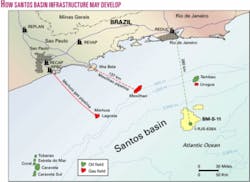Brazil’s state-owned company Petroleo Brasileiro SA (Petrobras) has big development plans for the Santos basin.
The Santos Basin Business Unit’s master plan calls for $18 billion in investment in the next 10 years.
The production goals for 2010-11 are 1.05 bcfd of gas and 100,000 b/d of oil, compared with 42 MMcfd and 10,000 b/d at present. The projected 1.05 bcfd is slightly more than the 990 MMcfd of gas Brazil now imports from Bolivia.
Of the Santos basin’s 352,000 sq km, 43% is in water as deep as 1,300 ft and 57% is in 1,300-10,000 ft of water. Twenty-five percent of the concession areas Petrobras holds in Brazil are in the Santos basin. Petrobras and partners hold 11.5% of the basin’s acreage.
Of the total area under concession, 52% lies off Sao Paulo state, 35% is off Rio de Janeiro, 7% is off Santa Catarina, and 6% is off Parana.
All indications are that the basin is only lightly explored, and the most recent discovery in its deepwater sector led some officials to speculate that the so far gas prone basin’s subsalt realm might become another Campos basin in terms of ultimate recovery.
Production poles
Petrobras describes five production poles, two of which are producing now and three more that will come into production in the next several years (OGJ, Aug. 28, 2006, p. 25). The five poles are:
- Cedro and giant Mexilhao fields 137 km off the Sao Sebastiao Terminal are to start producing early in the next decade, initially at 280-320 MMcfd of gas into facilities with a capacity of 530 MMcfd of gas and 20,000 b/d of condensate.
- Another pole, dubbed Polo Centro, includes unexplored areas seaward of Merluza and Lagosta fields. If it pans out, production could be tied back to Mexilhao.
- Merluza field, discovered in 1979 and producing gas-condensate since 1992, is making 42 MMcfd of gas and 1,600 b/d of condensate. Gas output is to climb to 88 MMcfd in 2008 when the platform begins accepting gas from nearby Lagosta field and from the SPS-25 well area. Installation of a second platform could boost gas handling capacity to 350 MMcfd by 2010.
Merluza-Lagosta and Mexilhao-Cedro will be connected to a $300 million gas treatment plant at Caraguatatuba. The plant would have two units with capacities of 265 MMcfd each, and could be expanded to 800 MMcfd. - Urugua and Tambau fields would anchor another production pole at Block BS-500 about 100 miles off Rio de Janeiro. Production there is estimated at 150,000-200,000 b/d of oil and 775 MMcfd of gas in 2011. Petrobras declared Urugua commercial in December 2005. Urugua and Tambau are in 3,280-4,600 ft of water. Urugua’s reserves are 250 million bbl of 33° gravity oil and 1.3 tcf of gas, and Tambau’s are 1.8 tcf of gas.
- The Southern Pole, 125 miles off Sao Paulo, Parana, and Santa Catarina states, produces 9,000 b/d of oil from the SS-11 platform off Parana from several declining fields. Cavalo Marinho field is to go on production in 2008 at 18,000 b/d, and Petrobras believes the area has the potential to deliver as much as 140,000 b/d and 105 MMcfd.
Deepwater subsalt
A great deal of optimism surrounds Petrobras’s recent deepwater subsalt discovery.
Petrobras, operator with 65% interest in Block BM-S-11, said the Tupi well in 6,975 ft of water 175 miles off Rio de Janeiro flowed 4,900 b/d of 30° gravity oil and 5.3 MMscfd of gas from a deep presalt reservoir (OGJ Online, Oct. 6, 2006). BG Group holds 25% interest and Petrogal 10% interest in the frontier block.
The well, which went to true vertical depth of 19,680 ft, is the first drilled on the block and the first to penetrate an evaporatic salt sequence more than 6,500 ft thick, Petrobras said.
The discovery “follows on from the discovery earlier this year of oil with the (Petrobras operated) Parati well some 70 km distant in Block BM-S-10,” BG said. Petrobras said Parati is noncommercial.
BG said it has built a “material exposure” to the new hydrocarbon province with equity interests ranging from 25 to 60% in seven blocks in the Santos basin that contain numerous prospects.
Petrobras geologists noted that Linguado and Badejo fields, discovered in 1978-79, respectively, produce subsalt light oil in shallow water in the Campos basin to the northeast off Rio de Janeiro.


